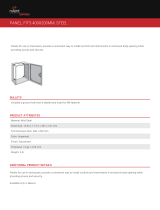
© 2022 nVent 89114993
- 2 -
NOTE: Some of the information in this manual may not apply if a special unit was
ordered. If additional drawings for a special unit are necessary, they have been inserted.
ContactnVentEquipment Protection if further information is required.
WARRANTY AND RETURN POLICY
https://hoffman.nvent.com/en/hoffman/warranty-information
IMPORTANT NOTICE
• These instructions were authored in English. Instructions published in languages other than English have been
translated from the authored language.
• These air conditioners are intended to be used by properly trained customers in industrial, communications and
agricultural environments.
• Operating sound level is below 70 dBA.
Disconnect the power source from
the air conditioner before servicing.
WARNING
TABLE OF CONTENTS
Warranty and Return Policy ............................................................................................................................................................. 2
IMPORTANT NOTICE ....................................................................................................................................................................... 2
RECEIVING THE AIR CONDITIONER ............................................................................................................................................... 3
HANDLING AND TESTING THE AIR CONDITIONER ...................................................................................................................... 3
INSTALLATION INSTRUCTIONS ..................................................................................................................................................... 4
Design Data ..................................................................................................................................................................................................... 4
Dimensional Drawing ..................................................................................................................................................................................... 4
Mounting Cutout Dimensions ........................................................................................................................................................................ 5
Components List ............................................................................................................................................................................................ 5
Wire Diagrams ................................................................................................................................................................................................. 6
Without Heat ........................................................................................................................................................................................... 6
With Heat ................................................................................................................................................................................................. 7
Schematic ....................................................................................................................................................................................................... 8
TEMPERATURE CONTROL .............................................................................................................................................................. 9
Units With heat ................................................................................................................................................................................................ 9
General Information ................................................................................................................................................................................ 9
Example ................................................................................................................................................................................................... 9
To change the temperature setting of the thermostat ........................................................................................................................ 9
Dial ranges ............................................................................................................................................................................................... 9
Testing thermostat calibration .............................................................................................................................................................. 9
PRINCIPLES OF OPERATION ........................................................................................................................................................ 10
MAINTENANCE ..............................................................................................................................................................................10
Compressor................................................................................................................................................................................................... 10
Inlet Air Filter ................................................................................................................................................................................................. 10
How To Remove, Clean or Install a New Inlet Air Filter ............................................................................................................................. 11
Condenser and Evaporator Air Movers ....................................................................................................................................................... 11
Refrigerant Loss............................................................................................................................................................................................ 11
TROUBLE SHOOTING ....................................................................................................................................................................12
Basic Air Conditioning Trouble Shooting Check List ................................................................................................................................. 12
Symptoms and Possible Causes: ............................................................................................................................................................... 13
F-GAS INFORMATION ....................................................................................................................................................................13






















